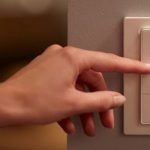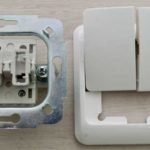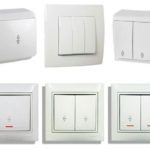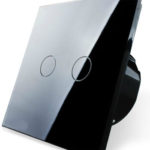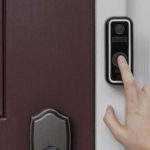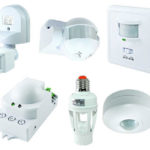A single-arm switch is considered a simple device used to control the lighting system in a room. Over time, it becomes necessary to replace or repair such an element of the electrical system, so it is necessary to understand the principle of operation and features of the wiring diagram.

It is a single pushbutton switch for switching on and off one category of light sources. It is controlled by a single button that has two positions. In practice, the installation of the switch often raises a lot of questions. Before carrying out repair or replacement work, it is necessary to find out the functional purpose of all wires and only then perform the connection of the device.
Contents
Where can the single wall switch be used?
The internal construction of a standard single push-button switch assumes the presence of a source and consumer of electricity, which are the mains 220 V and the lamp. In order to turn the device on and off, there must be a disconnecting element between these components of the system.
The single-key switch is connected in the phase line of the power supply in series. Including it in the zero break is not recommended, because this scheme is not safe for the operation of electrical equipment. The reason for the error of this method of installation is the fact that when the device is installed in the zero gap, the lamp will remain energized even when the switch is off. If a person touches the device, he or she may get an electric shock.
The design of a single-arm light bulb switch involves the use of a junction box where the switching is done. There are 6 wires connected to it, two of which supply 220 volts, and two lines each go to the lamp and the single-arm switch.
The use of single-arm switches is useful in situations where you want to switch the wire to power a single lamp or lamp fixture. If it is necessary to connect a chandelier with a large number of lamps, then it is recommended to install a device with several keys responsible for certain lamps in the chandelier.
How to choose the right single clutch switch
Based on the category of wiring in an apartment or private home, the following types of single-key light switches can be used:
- for outdoor installation;
- for concealed installation.
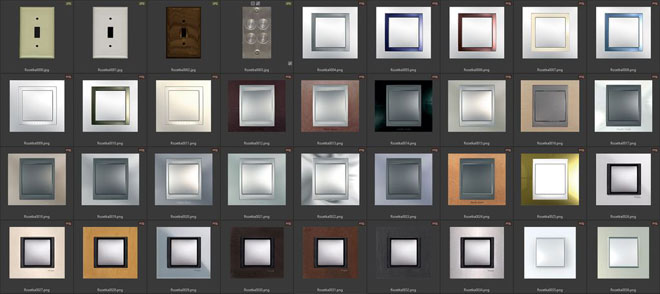
The difference between them lies in the way they are mounted on the wall. When mounted externally, the device is fixed to a wooden plate placed on the wall. In the second case, the single-switch is mounted inside a recessed socket in the wall. For concealed installation, it is necessary to pre-drill a hole of suitable depth.
When selecting a product, it is necessary to take into account its limits. In most cases, the indicator of the working voltage is 220V, and the actual current is 10A. In the passport of the product specifies the maximum allowable switching power, the standard value is 2.2 kW. Thus, the power of the luminaire must be within the specified power.
Installation and mounting rules
Initially, we note that the installation of the single-switch switch should be carried out in compliance with these rules:
- work is carried out only when the voltage is off;
- Only the phase wires must be switched, The neutral wire goes directly to the lamp;
- the flush-mounted switch is convenient to connect if the length of the wiring in the socket is not less than the diameter of the switch;
- It is recommended that the wire insulation be stripped with a wire stripper.
When installing a standard single-key switch, special attention should be paid to the following nuances: the correct connection of wires in the junction box and the switch itself.
The sequence of connecting components in the junction box is as follows:
- Determine the phase that comes from the power side. For this purpose is suitable indicator screwdriver with a neon bulb. When it is brought to the phase, the neon bulb lights up;
- Disconnect the voltage at the apartment's switchboard;
- connect the phase to one of the wires going to the switch;
- connect the second wire from the switch to the wire to the center contact of the lamp base;
- then connect the cable from the outer contact of the lamp socket to the zero.
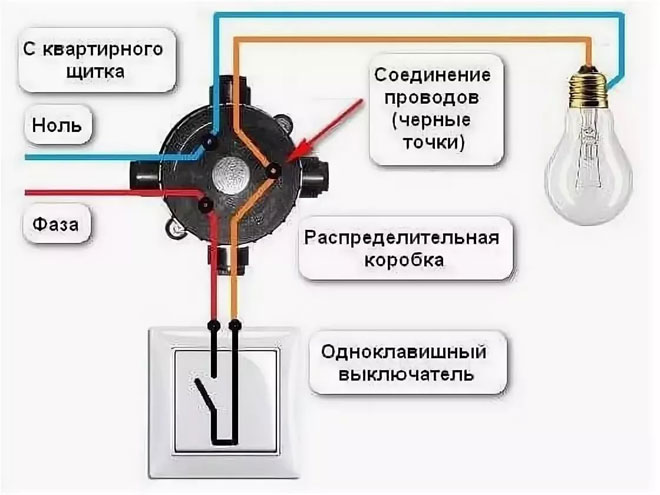
Wires are connected to the bulb in the junction box by different methods:
- Twisting and further soldering with insulation of this section with tape or plastic PPE cap;
- screw terminals;
- terminal blocks;
- spring clips.
The most reliable connection and contact is ensured by the first method. Screw and bolt connections can damage the components to be connected directly, especially if the person performing the task lacks practice and experience. The springs may stretch during operation, which can cause sparks and fire.
In order to connect a single-switch light switch, the following steps are necessary:
- Remove the off button with a flat screwdriver. And it is necessary to act with maximum caution and accuracy, because some models are made of fragile plastic, which can be damaged;
- fix the device with the external type of fixation with screws on the socket and use screws to connect the wires to the contacts;
- For the concealed type, you must first connect the wires and then insert the housing into the recess of the wall and secure it with the feet provided by tightening the fixing screws. In this case, the sub-socket is fixed in the niche and checked the reliability of attachment, only after that is mounted single-switch;
- After performing this sequence of actions, insert the key in its place.
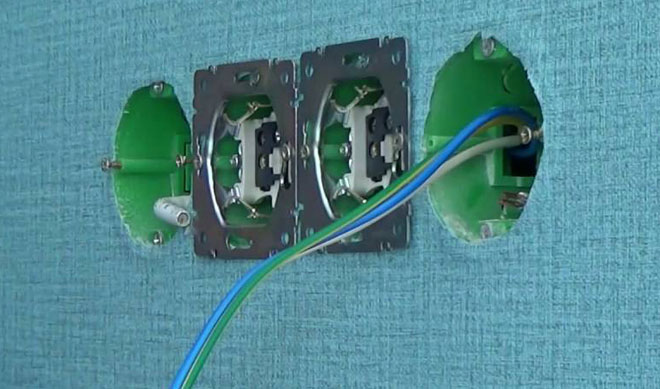
If the existing jack is defective due to prolonged use, it must be replaced in the preparatory phase. In particular, the replacement of the socket may appear in rooms with high humidity, in order to reduce the risk of damping of wiring and short circuit. The main task in this case is not to damage the wiring. The sequence of actions is as follows:
- Use a punch or a chisel to chisel the plaster around the socket by hand until it is released;
- Then it is removed and a new subcorner is inserted on the existing wires and fixed with plaster or alabaster compound;
- It is necessary to wait for complete hardening, and only then perform further installation;
- Then unscrew the fastening screws of the expansion clamps so that the sealing rubber provides the tightest possible fit to the body - then the switch will enter all the way into the sub-socket;
- Hold the switch and tighten the screws until it is fully locked, insert the button and after turning on the voltage on the panel, check the switch to turn on the light.
So, single knob switches are used to control individual lights. The switch must be connected to the phase wire in series with the light bulb. The switch should be selected so that its maximum current rating on the data sheet is not less than the current flowing through the switch.
Related articles:
